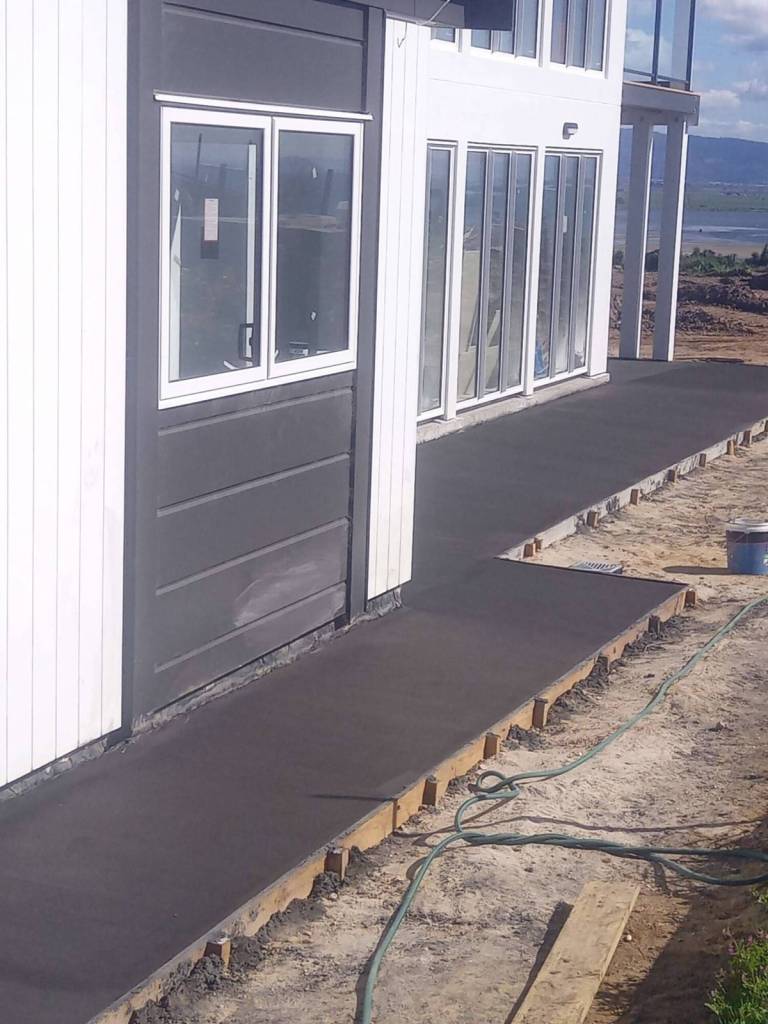At Rock Solid Worx, we specialise in creating sturdy, long-lasting concrete footpaths in Hamilton that blend seamlessly with your landscape. Whether for residential, commercial, or public spaces, our custom footpaths provide safe, aesthetically pleasing walkways that withstand heavy foot traffic and harsh weather conditions.
Why Opt for a Concrete Footpath?
Concrete is the preferred material for footpaths thanks to its proven performance and lasting value.
Long-Lasting
Concrete stands up to heavy foot traffic and Hamilton’s varying weather conditions without cracking, sinking, or deteriorating over time.
Low Maintenance
Concrete footpaths need minimal upkeep compared to materials like gravel or wood, making them a practical and cost-effective solution in the long run.
Enhanced Safety
With slip-resistant finishes available, concrete footpaths can be tailored for improved safety — ideal for Hamilton areas that experience frequent rain or frost.
Concrete Footpath Installation Process
Site Evaluation and Preparation
We begin by assessing the site, ensuring the footpath’s design accounts for natural terrain and drainage requirements. Proper excavation is critical for creating a stable base that will prevent future settling.
Excavation and Base Laying
Our team excavates the area to the required depth, typically around 4-6 inches. A base layer of crushed stone or gravel is installed to promote drainage and stability.
Formwork and Concrete Pouring
The next step involves setting up the formwork to guide the shape of the path. Once the concrete is poured, we ensure the surface is level and reinforced where necessary to prevent cracking.
Finishing and Curing
After levelling, the concrete is left to cure. During this time, we can add finishes such as broomed or stamped patterns for improved traction and visual appeal.
The Importance of Proper Drainage
Proper drainage is crucial for any footpath installation to prevent water pooling and subsequent damage. Our team ensures that every footpath we install has the necessary slope and drainage solutions to avoid long-term issues

frequently asked questions
The typical thickness for a concrete footpath is 4 inches (100 mm). This thickness is sufficient for pedestrian traffic and light use areas. However, if the footpath will experience heavier loads, such as occasional vehicle traffic or bikes, a thickness of 5 to 6 inches may be recommended to provide additional strength and prevent cracking. For strong durability, a reinforced concrete mix with steel mesh or rebar can also be used.
Joints in concrete footpaths are necessary to control cracking as the concrete expands and contracts with temperature changes. The general rule is to place joints at a spacing of 4-6 feet, which is roughly 2-3 times the thickness of the slab (in inches). For a 4-inch thick footpath, joints should be spaced every 8-12 feet. These joints can be either control joints, which are sawed into the slab after it’s poured, or expansion joints that provide movement flexibility.
The best concrete mix for a footpath is typically a standard mix of 1 part cement, 2 parts sand, and 4 parts coarse aggregate (gravel or crushed stone). This results in a mix with a compressive strength of 3,500 to 4,000 psi, which is suitable for most footpaths. Adding reinforcement, such as steel mesh or rebar, can further improve strength. If the footpath is exposed to freeze-thaw cycles or heavy moisture, using a mix with air-entraining agents is recommended to increase durability and reduce the risk of cracking.
The depth of the concrete for a path is generally 4 inches (100 mm). This is the most common depth for footpaths that experience standard pedestrian use. For areas subject to heavier loads or more frequent traffic, increasing the depth to 5 or 6 inches is advisable to prevent damage or cracking. Additionally, the base layer (gravel or crushed stone) beneath the concrete should be compacted to a depth of 2-4 inches to ensure proper drainage and support.
Placing plastic (polyethylene sheeting) under a concrete footpath is not always necessary, but it can be beneficial in certain situations ie shed and house concrete pads/foundations. The plastic acts as a vapour barrier to prevent moisture from seeping up through the concrete, which can weaken the slab over time. In areas with high groundwater or moisture levels, it is recommended to use plastic sheeting. However, for most outdoor footpaths, a well-compacted gravel base provides adequate drainage and reduces the need for a vapour barrier. It’s important to consult a contractor based on your specific soil conditions.

